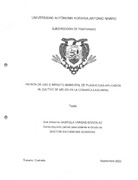Mostrar el registro sencillo del ítem
Patrón de uso e impacto ambiental de plaguicidas aplicados al cultivo de melón en la Comarca Lagunera
| dc.contributor.advisor | Álvarez Reyna, Vicente de Paul | |
| dc.contributor.author | Vargas González, Gabriela | |
| dc.contributor.other | Cano Ríos, Pedro | |
| dc.contributor.other | Jiménez Díaz, Florencio | |
| dc.contributor.other | García Carrillo, Mario | |
| dc.contributor.other | Vásquez Arroyo, Jesús | |
| dc.contributor.other | Guigón López, César | |
| dc.date.accessioned | 2022-10-03T15:19:01Z | |
| dc.date.available | 2022-10-03T15:19:01Z | |
| dc.date.issued | 2022-09-01 | |
| dc.identifier.uri | http://repositorio.uaaan.mx/xmlui/handle/123456789/48704 | |
| dc.description.abstract | "El uso intensivo de plaguicidas altamente tóxicos, en la producción de cultivos hortofrutícolas especializados, conlleva riesgos ambientales y sociales, que pueden medirse mediante indicadores de riesgo de plaguicidas, para evaluar el potencial de impacto negativo de estos productos en los ecosistemas y comparar los logros de la implementación de prácticas agrícolas sustentables, en términos de reducción de riesgos, por la utilización de plaguicidas. El objetivo de esta investigación fue estimar el potencial impacto ambiental, por uso de plaguicidas, en las tres áreas de mayor producción de melón en la Comarca Lagunera. Se realizó un estudio descriptivo transversal, mediante la aplicación de una encuesta en 19 predios, seleccionados mediante muestreo no probabilístico. El Impacto Ambiental (IA) se evaluó mediante el modelo del Cociente de Impacto Ambiental (CIA), que se basa en el cálculo del CIA y el Cociente de Impacto Ambiental en Campo (CIAC). Los resultados muestran que los plaguicidas que contribuyeron con la mayor carga ambiental en las áreas de estudio fueron: clorotalonil (49 %), azufre elemental (11 %) y endosulfan (10 %), en Mapimí; carbofuran (19 %), endosulfan (18 %) y carbendazim (12 %), en Matamoros-Viesca; y oxicloruro de cobre (20 %), endosulfan (17 %) y mancozeb (17 %), en Tlahualilo. Los sistemas de producción, con los valores del IA más altos, se identificaron en fechas de siembra intermedias (199 a 500) y tardías (201 a 701), en Mapimí, y fechas tardías (132 a 383) en MatamorosViesca. El modelo del CIA permitió identificar a los plaguicidas y los sistemas de producción con el mayor impacto ambiental negativo en las tres principales áreas de producción de melón en la Comarca Lagunera, además de proporcionar una escala cuantificable, que permitirá evaluar y comparar futuros cambios en el uso regional de plaguicidas" | es_MX |
| dc.format | es_MX | |
| dc.language | Español | es_MX |
| dc.publisher | Universidad Autónoma Agraria Antonio Narro | es_MX |
| dc.rights | Acceso Abierto | es_MX |
| dc.rights.uri | CC BY-NC-ND - Atribución-NoComercial-SinDerivadas | es_MX |
| dc.subject | CIENCIAS AGROPECUARIAS Y BIOTECNOLOGÍA | es_MX |
| dc.subject.other | Control químico, Indicadores de riesgo de plaguicidas, Cociente de impacto ambiental. | es_MX |
| dc.title | Patrón de uso e impacto ambiental de plaguicidas aplicados al cultivo de melón en la Comarca Lagunera | es_MX |
| dc.type | Tesis de doctorado | es_MX |
| dc.description.abstractEn | "The intensive use of highly toxic pesticides in the production of specialized horticultural crops entails environmental and social risks that can be measured through pesticide risk indicators to assess the potential negative impact of these products on ecosystems. In addition, this measurement enables the comparison of the achievements that result from the implementation of sustainable agricultural practices in terms of risk reduction due to the use of pesticides. The objective of this research was to estimate the potential environmental impact due to the use of pesticides in three melon production areas in the Comarca Lagunera. A cross-sectional descriptive study was carried out by applying a survey in 19 properties selected by non-probabilistic sampling. The Environmental Impact (EI) was evaluated using the Environmental Impact Quotient (EIQ) model, which is based on the calculation of the EIQ and the Environmental Impact Quotient in the Field (EIQF). The results show that the pesticides that contributed with the greatest environmental burden in the study areas were: Chlorothalonil (49 %), elemental sulfur (11 %) and endosulfan (10 %) in Mapimí; carbofuran (19 %), endosulfan (18 %) and carbendazim (12 %) in Matamoros-Viesca, and copper oxychloride (20 %), endosulfan (17 %) and mancozeb (17 %) in Tlahualilo. The production systems with the highest AI values were identified on intermediate (199 to 500) and late (201 to 701) sowing dates in Mapimí and late dates (132 to 383) in Matamoros-Viesca. The EIQ model allowed the identification of pesticides and production systems with the greatest negative environmental impact in the main areas of melon production in the Comarca Lagunera and provides a quantifiable scale that will allow the evaluation and comparison of future changes in the regional use of pesticides" | es_MX |
| dc.type.version | Versión publicada | es_MX |
| dc.audience | Estudiantes | es_MX |
| dc.audience | Investigadores | es_MX |
| dc.publisher.place | Torreón, Coahuila, México | es_MX |
